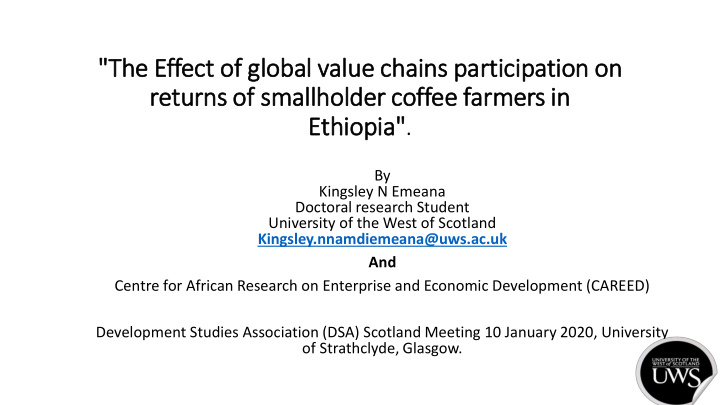



"Th "The Effect t of glo global valu lue ch chains part rticipation on retu turns of f smallholder coffee farm rmers in in Eth thiopia". By Kingsley N Emeana Doctoral research Student University of the West of Scotland Kingsley.nnamdiemeana@uws.ac.uk And Centre for African Research on Enterprise and Economic Development (CAREED) Development Studies Association (DSA) Scotland Meeting 10 January 2020, University of Strathclyde, Glasgow.
In Intr troductio ion ▪ Smallholder farmers are mainstay of ▪ More than 85% of coffee producers agricultural production in developing worldwide are smallholder farmers and they countries. produce in the rural areas (Assefa et al., 2015). ▪ Smallholder farmers are defined in terms of: land size (varies according to ▪ Coffee: world’s favourite beverage and countries) and units of labour (FAO, largest consumed commodity; also second 2004; OECD, 2015; UNCTAD, 2015a). most traded commodity, is predominantly ▪ 2.5 billion people globally depend produced by smallholders in developing countries (Minten et al., 2014; Fundira, partially or completely on agricultural 2015). production for means of livelihood(UNCTAD, 2015b). ▪ Coffee production overall has been in ▪ 1.5 billion of them are smallholder decline for two consecutive year while farmers and they supply 70% of the consumption has increase with about 1.3% total global food production (FAO, contributing to coffee price volatility (ICO, 2011; UNCTAD, 2015b). 2017b).
• From an overall population of 105 million 15 million Coffee production in Ethiopia people depend on coffee production for survival ▪ Ethiopia regarded as the birthplace and 1.2 million are smallholder producers,(Ferris et of Arabica coffee and is known for its high al., 2014; Troster, 2015; Wordometer, 2017) quality. • Most coffee smallholder farmers belong to a ▪ Coffee is very significant in social gathering cooperative and produce on less than 2ha of land and local consumption. (Ferris et al., 2014; Minten et al., 2014; Troster, ▪ Ethiopia consumes up 50% of its coffee 2015). production (Ferris et al., 2014; Minten et al., • Cooperatives play significant role in aggregating 2014; Troster, 2015). small quantities of coffee from smallholder farmers ▪ Coffee production is predominately in rural and export through coffee unions. areas mainly in the South and West of Ethiopia with Yirgacheffe, Sidamo and Haraar • The quantities produced are often too small to meet the leading areas for premium quality coffee. the requirements of participating in global value ▪ Eighth largest exporting country in the world chains (GVCs). and second largest in Africa after Uganda • Inefficient transport systems, collection processes, with Brazil largest exporting country in the world (ICO, 2017a). unorganised and fragmented markets, poor processing methods, traceability issues are factors ▪ Coffee exports account 30% of Ethiopia’s total affecting coffee production foreign exchange revenues (Troster, 2015; Mohan et al. 2016).
Global Value chains Participation and Coffee returns ▪ Global value chains (GVCs) is a framework that have ▪ GVCP associated with efficiency and value, how become very prominent amongst economic efficient is Ethiopian coffee sector? development researchers. ▪ Ethiopian Commodity market (ECX) a former ▪ Argument whether GVCs is to advance neo-liberal or market to interact between global market and pro-poor development objectives (Dalle et al. 2014). domestic producers? Many of these smallholder ▪ GVC provides a platform form economic and social farmers and their cooperative unions participate in upgrading. this Exchange market? • GVCs participation offers opportunities and threats to ▪ Survey showed 418 smallholder farmers and their participating countries/firms. cooperatives trade direct in the domestic market ▪ Ethiopia is at the bottom of coffee value chains and foreign buyers. (Producers). ▪ Processing and traceability. • Most smallholder farmers are not export oriented ▪ Quality and lack the capacity to participate in the GVC (Volume, bargaining power, storage, and ▪ Access to finance . technicalities. ▪ Cooperative unions act as agents for these producers in the international market.
3 2 1 4 4 7 8 6 5 9 10 11 5 23/01/2020 United Nations Conference on Trade and Development
Empirical approach ▪ This study aims to contribute to the empirical • Binary logistics was used to run the regression. literature by examining the robustness of • GVCP I = 𝜷 + 𝜸 𝟐 𝑸 𝒋 + 𝜸 𝟑 𝑺 𝒋 + 𝜻 i factors frequently suggested in previous • Where GVCP means Global value chains Participation (Question: 23) academic papers in predicting the probability of participation in the international coffee • P means productivity (Questions 18/13) market by small scale producers in Ethiopia • R means Returns (Question: 21) compared with their large scale counterparts. ▪ Dependent variable is the measure of participation in the international coffee export Result market. From the questionnaire, this is captured by the response to question 23 Variables in the Equation recoded as (yes = 1, No = 0) ▪ Explanatory variables: Two explanatory B S.E. Wald df Sig. Exp(B) Step 1 a P .702 .228 9.495 1 .002 2.018 variables to test GVCP used which are returns (captured in question 21) and productivity R -.062 .200 .096 1 .756 .940 (captured 18/13) Constant -2.672 .344 60.272 1 .000 .069 • Out of 600 farmers surveyed in 3 different a. Variable(s) entered on step 1: P, R regions (Harar, Sidama and Yirgacheffe) 583 where correctly answered and returned. • But the focus for today is on Just GVCP.
Findings and Conclusions • Lack of rural road network • Too many middlemen • Inefficient means of transportation • Lack adequate storage facilities ▪ Rural-Urban migration and processing facilities for the ▪ High level of illiteracy amongst these farmers cooperatives ▪ Inefficient manpower • Absence of private investors ▪ Manual farming process and extension services. ▪ Khat farming competing with coffee production • Bank requirements and (Risk management mitigation) collateral barrier to credit ▪ Government working to improve road network access. ▪ Police recommendation: Warehouse receipt to be • Large domestic consumer issued to smallholder farmers and duration market increased. ▪ Strong Private Institutions encouraged.
Thanks for Listening
Recommend
More recommend